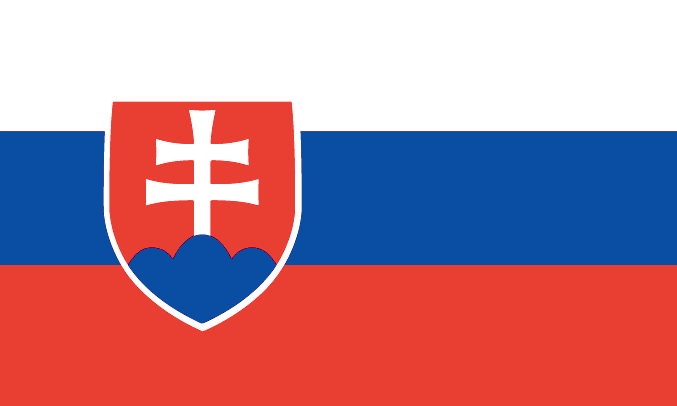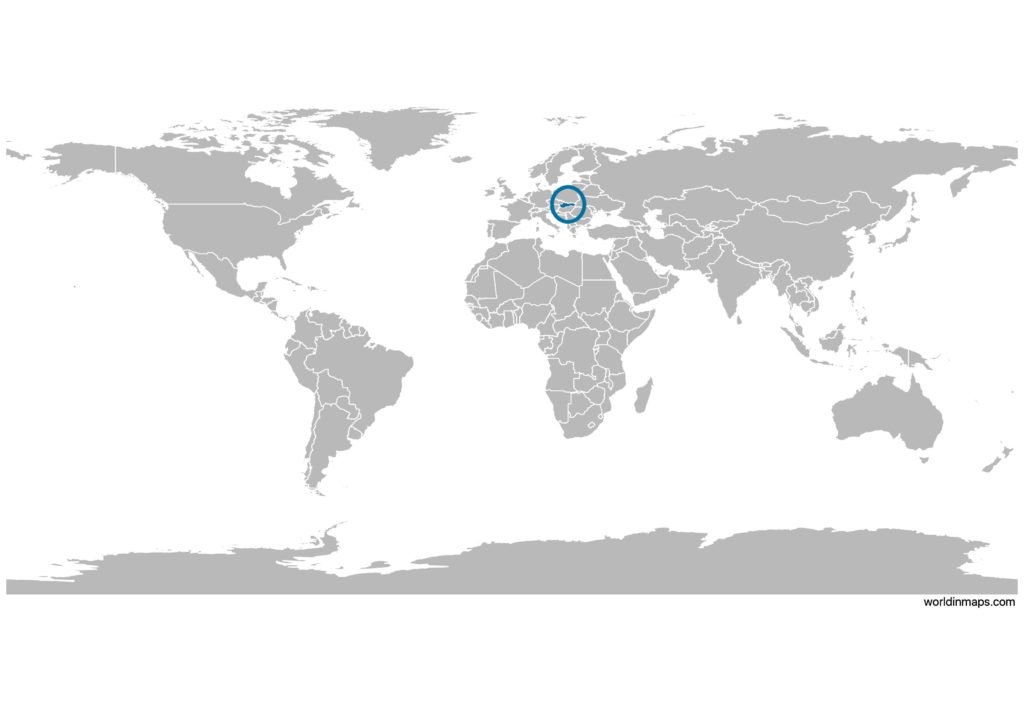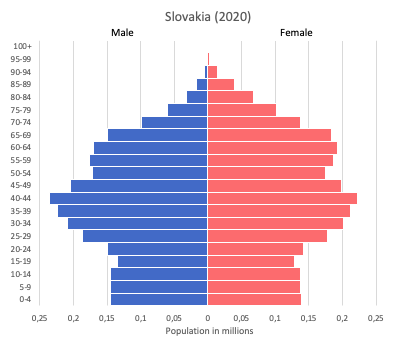Slovakia

| Government | |
| Name | Slovak Republic |
| Slovak | Slovenská republika |
| Government type | parliamentary republic |
| Capital | Bratislava (432,801 (2011)) |
| Currency | Euro (EUR) |
| People | |
| Population (2020) | 5,459,643 (119th) |
| Density of population | 111 P/km2 (88th) |
| Nationality | Slovak |
| Official languages | |
| Slovak | |
| Ethnic groups (2011) | |
| Slovak | 80.7% |
| Hungarian | 8.5% |
| Romani | 2% |
| Czech | 0.6% |
| Ruthenian | 0.6% |
| Ukrainian | 0.1% |
| German | 0.1% |
| Polish | 0.1% |
| Moravian | 0.1% |
| Unspecified | 7.2% |
| Religions (2011) | |
| Roman Catholic | 62% |
| Protestant | 8.2% |
| Greek Catholic | 3.8% |
| other or unspecified | 12.5% |
| None | 13.4% |
| Life expectancy (2020) | |
| Male | 74.3 years |
| Female | 81.6 years |
| Total population | 77.8 years (75th) |
| Homicides | |
| Total (2018) | 1.1 per 100,000 people (136th) |
| Geography | |
| Land area | 48,105 km2 |
| water area | 930 km2 |
| total area | 49,035 km2 (131st) |
| Mean elevation | 458 m |
| Lowest point | |
| Bodrok River | 94 m |
| Highest point | |
| Gerlachovsky Stit | 2,655 m |
| Land use (2011) | |
| Agricultural land | 40.1% |
| Arable land | 28.9% |
| Permanent crops | 0.4% |
| Permanent pasture | 10.8% |
| Forest | 40.2% |
| Other | 19.7% |
| Urbanization | |
| Urban population (2020) | 53.8% |
| Rate of urbanization | 0% annual rate of change (2015 – 2020) |
| Economy | |
| Labor force (2017) | 2.758 million (110th) |
| Labor force by occupation (2015) | |
| Agriculture | 3.9% |
| Industry | 22.7% |
| Services | 73.4% |
| Unemployment rate (2017) | 8.1% (119th) |
| GDP (PPP) (estimate 2020) | |
| Total | $209.186 billion (68th) |
| Per capita | $38,321 (37th) |
| GDP (nominal) (estimate 2020) | |
| Total | $111.874 billion (60th) |
| Per capita | $20,495 (40th) |
| GDP by sector (estimate 2017) | |
| Agriculture | 3.8% |
| Industry | 35% |
| Services | 61.2% |
| Exports (2017) | $80.8 billion (40th) |
| Exports partners (2017) | |
| Germany | 20.7% |
| Czech Republic | 11.6% |
| Poland | 7.7% |
| France | 6.3% |
| Italy | 6.1% |
| UK | 6% |
| Hungary | 6% |
| Austria | 6% |
| Imports (2017) | $80.07 billion (42nd) |
| Imports partners (2017) | |
| Germany | 19.1% |
| Czech Republic | 16.3% |
| Austria | 10.3% |
| Poland | 6.5% |
| Hungary | 6.4% |
| South Korea | 4.5% |
| Russia | 4.5% |
| France | 4.3% |
| China | 4.2% |
Slovakia on the world map

Slovakia top 10 largest cities (2011)
- Bratislava (432,801)
- Košice (240,688)
- Prešov (91,638)
- Žilina (81,515)
- Banská Bystrica (79,775)
- Nitra (78,875)
- Trnava (66,219)
- Martin (57,300)
- Trenčín (55,832)
- Poprad (52,791)
Demography
Population pyramid

Age structure data
Estimate for 2020:
- 0-14 years: 15.13% (male 423,180/female 400,128)
- 15-24 years: 10.06% (male 280,284/female 266,838)
- 25-54 years: 44.61% (male 1,228,462/female 1,198,747)
- 55-64 years: 13.15% (male 342,124/female 373,452)
- 65 years and over: 17.05% (male 366,267/female 561,120)
Remark: the age structure of a population affects a nation’s key socioeconomic issues. Countries with young populations (high percentage under age 15) need to invest more in schools, while countries with older populations (high percentage ages 65 and over) need to invest more in the health sector. The age structure can also be used to help predict potential political issues. For example, the rapid growth of a young adult population unable to find employment can lead to unrest.
Population from 1950 to 2020
Source: United Nations, Department of Economic and Social Affairs, Population Division (2019). World Population Prospects 2019, Online Edition. Rev. 1.
Evolution of the life expectancy from 1960 to 2018
Source: World Development Indicators, The World Bank
Economy
Agriculture:
grains, potatoes, sugar beets, hops, fruit, pigs, cattle, poultry, forest products
Industries:
automobiles, metal and metal products, electricity, gas, coke, oil, nuclear fuel, chemicals, synthetic fibers, wood and paper products, machinery, earthenware and ceramics, textiles, electrical and optical apparatus, rubber products, food and beverages, pharmaceutical
Exports – commodities (2015):
vehicles and related parts 27%, machinery and electrical equipment 20%, nuclear reactors and furnaces 12%, iron and steel 4%, mineral oils and fuels 5%
Imports – commodities (2015):
machinery and electrical equipment 20%, vehicles and related parts 14%, nuclear reactors and furnaces 12%, fuel and mineral oils 9%
Time zone and current time in Slovakia
Go to our interactive map to get the current time in Slovakia